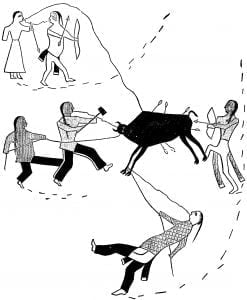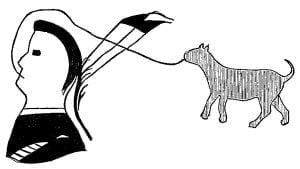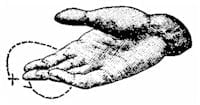Language
Signals – Signals in Which Objects Are Used in Connection With Personal Action – Sign Language
Buffalo Discovered. See also Notes on Cheyenne and Arapaho signals When the Ponkas or Omahas discover buffalo the watcher stands erect on the hill, with his face toward the camp, holding his blanket with an end in each hand, his arms being stretched out (right and left) on a line with, shoulders. (Dakota VIII; Omaha I; Ponka I.) See Fig. 337. Signal for “buffalo discovered.” Same as (Omaha I), and (Ponka I); with the addition that after the blanket is held out at arm’s length the arms are crossed in front of the body. (DakotaI.) Camp! When it is intended … Read more
Sign Language Among North American Indians
Sign language among North American Indian tribes served as a surprisingly uniform and effective means of communication, transcending linguistic barriers across various tribes, especially during trade interactions. This book delves into the development, use, and structure of sign language among these tribes, offering insights into its history and the wide range of gestures employed. It also explores the connections between sign language and other communication methods like smoke and fire signals, while providing a detailed compilation of signs for common words and phrases. The research presented is based on extensive fieldwork and collaboration with experts, contributing to a broader understanding of sign language both within Native American culture and in comparison, to other sign systems globally.
Sign Language with Reference to Grammar
Apart from the more material and substantive relations between signs and language, it is to be expected that analogies can by proper research be ascertained between their several developments in the manner of their use, that is, in their grammatic mechanism, and in the genesis of the sentence. The science of language, ever henceforward to be studied historically, must take account of the similar early mental processes in which the phrase or sentence originated, both in sign and oral utterance. In this respect, as in many others, the North American Indians may be considered to be living representatives of prehistoric … Read more
Results Sought in the Study of Sign Language
These may be divided into (1) its practical application, (2) its aid to philologic researches in general with (3) particular reference to the grammatic machinery of language, and (4) its archæologic relations. Practical Application The most obvious application of Indian sign language will for its practical utility depend, to a large extent, upon the correctness of the view submitted by the present writer that it is not a mere semaphoric repetition of motions to be memorized from a limited traditional list, but is a cultivated art, founded upon principles which can be readily applied by travelers and officials, so as … Read more
Scheme of Illustration – Sign Language
In the following pages the scheme of graphic illustration, intended both to save labor and secure accuracy, which was presented in the Introduction to the Study of Sign Language, is reproduced with some improvements. It is given for the use of observers who may not see that publication, the material parts of which being included in the present paper it is not necessary that the former should now be furnished. The Types of Hand Positions were prepared for reference by the corresponding letters of the alphabet to avoid tedious description, should any of them exactly correspond, or by alteration, as … Read more
Signals – Smoke Signals – Sign Language
Sign Language Among North American Indians – Signals Made When the Person of the Signalist is Not Visible
Notable Points for Further Researches – Sign Language
Sign Language Among North American Indians – Notable Points for Further Researches
Relations to Philology – Sign Language
Sign Language Among North American Indians – Relations to Philology
Narrative – Patricio’s – Sign Language
Sign Language Among North American Indians – Patricio’s Narrative
Permanence of Signs – Sign Language
Sign Language Among North American Indians – Permanence of Signs
Omaha Colloquy & Brulé Dakota Colloquy – Sign Language
Sign Language Among North American Indians – Omaha Colloquy
Once Probably Universal in North America – Sign Language
Sign Language Among North American Indians – Once Probably Universal in North America
Its Origin from One Tribe or Region – Sign Language
Sign Language Among North American Indians – Its Origin from One Tribe or Region
Not Correlated with Meagerness of Language – Sign Language
Sign Language Among North American Indians – Not Correlated with Meagerness of Language
Signals – Notes on Cheyenne and Arapaho Signals – Sign Language
Sign Language Among North American Indians – Notes on Cheyenne and Arapaho Signals
Ojibwa Dialogue – Sign Language
Sign Language Among North American Indians – Ojibwa Dialogue









